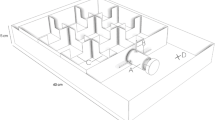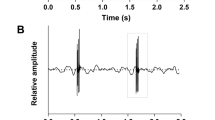Abstract
The frequency and function of arousals during hibernation in free-living mammals are little known. We used temperature-sensitive radio transmitters to measure patterns of torpor, arousal and activity in wild Natterer’s bats Myotis nattereri during hibernation. Duration of torpor bouts ranged from 0.06 to 20.4 days with individual means ranging from 0.9 to 8.9 days. Arousals from torpor occurred most commonly coincident with the time (relative to sunset) typical for bats emerging from summer roosts to forage. Bats with lower body condition indices had a shorter average duration of their torpor bouts. We found a non-linear relationship between duration of torpor bout and ambient temperature: the longest average torpor bouts were at temperatures between 2 and 4°C with shorter bouts at lower and higher ambient temperatures. One individual was radio-tracked for ten nights, remained active for an average of 297 min each night and was active for longer on warmer nights. Our results suggest that vespertilionid bats use relatively short torpor bouts during hibernation in a location with a maritime climate. We hypothesise that Natterer’s bats time arousals to maximise opportunities for potential foraging during winter although winter feeding is not the sole determinant of arousal as bats still arouse at times when foraging is unlikely.





Similar content being viewed by others
References
Audet D, Thomas DW (1996) Evaluation of the accuracy of body temperature measurement using external radio transmitters. Can J Zool 74:1778–1781
Avery MI (1985) Winter activity of pipistrelle bats. J Anim Ecol 54:721–738
Avery MI (1986) The winter activity of noctule bats (Nyctalus noctula). J Zool 209:296–299
Baumer J, South FE, Fellen L, Zatzman ML (1971) A possible basis for periodic arousals during hibernation: accumulation of ketone bodies. Life Sci 10:463–471
Blehert DS, Hicks AC, Behr M, Meteyer CU, Berlowski-Zier BM, Buckles EL, Coleman JTH, Darling SR, Gargas A, Niver R, Okoniewski JC, Rudd RJ, Stone WB (2009) Bat white-nose syndrome: an emerging fungal pathogen? Science 323:227
Boyles JG, Brack V (2009) Modeling survival rates of hibernating mammals with individual-based models of energy expenditure. J Mammal 90:9–16
Boyles JG, Dunbar MB, Whitaker JO Jr (2006) Activity following arousal in winter in North American vespertilionid bats. Mammal Rev 36:267–280
Brigham RM (1987) The significance of winter activity by the big brown bat Eptesicus fuscus: the influence of energy reserves. Can J Zool 65:1240–1242
Burton RS, Reichman OJ (1999) Does immune challenge affect torpor duration? Funct Ecol 13:232–237
Cryan PM, Meteyer CU, Boyles JG, Blehert DS (2010) Wing pathology of white-nose syndrome in bats suggests life-threatening disruption of pathology. BMC Biol 8:135
Csorba G, Ujhelyi P, Thomas N (2003) Horseshoe bats of the world (Chiroptera: Rhinolophidae). Alana books, Shropshire
Daan S (1973) Activity during natural hibernation in three species of vespertilionid bats. Neth J Zool 23:1–71
Daan S, Barnes BM, Strijkstra AM (1991) Warming up for sleep? Ground squirrels sleep during arousal from hibernation. Neurosci Lett 128:265–268
Dausmann KH, Glos J, Ganzhorn JU, Heldmaier G (2004) Hibernation in a tropical primate. Nature 429:825–826
Dietz C, von Helversen O, Nill D (2009) Bats of Britain, Europe and northwest Africa. A and C Black, London
Dunbar MB, Tomasi TE (2006) Arousal patterns, metabolic rate, and an energy budget of eastern red bats (Lasiurus borealis) in winter. J Mammal 87:1096–1102
Entwistle AC, Racey PA, Speakman JR (1998) The reproductive cycle and determination of sexual maturity in male brown long-eared bats, Plecotus auritus (Chiroptera: Vespertilionidae). J Zool 244:1–63
Fowler PA, Racey PA (1990) Daily and seasonal cycles of body temperature and aspects of heterothermy in the hedgehog Erinaceus europaeus. J Comp Physiol B 160:299–307
French AR (1976) Periodicity of recurrent hypothermia during hibernation in the pocket mouse, Perognathus longimembris. J Comp Physiol A 115:87–100
French AR (1985) Allometries of the durations of torpor and euthermic intervals during mammalian hibernation: a test of the theory of metabolic control of the timing and changes in body temperature. J Comp Physiol B 156:13–19
Frick WF, Pollock JF, Hicks AC, Langwig KE, Reynolds DS, Turner GG, Butchkoski CM, Kunz TH (2010) An emerging disease causes regional population collapse of a common North American bat species. Science 329:679–682
Galster WA, Morrison P (1972) Cyclic changes in carbohydrate concentrations during hibernation in the arctic ground squirrel. Am J Physiol 218:1228–1232
Geiser F, Ruf T (1995) Hibernation versus daily torpor in mammals and birds: physiological variables and classification of torpor patterns. Physiol Zool 68:935–966
Gregor F, Bauerova Z (1987) The role of Diptera in the diet of Natterer’s bat, Myotis nattereri. Folia Zool 36:13–19
Guilday JE (1948) Little brown bats copulating in winter. J Mammal 29:416–417
Guthrie MJ (1933) Notes on the seasonal movements and habits of some cave bats. J Mammal 14:1–19
Hays GC, Speakman JR, Webb PI (1991) Why do brown long-eared bats (Plecotus auritus) fly in winter? Physiol Zool 65:554–567
Heller HC, Ruby NF (2004) Sleep and circadian rhythms in mammalian torpor. Annu Rev Physiol 66:275–289
Humphries MM, Kramer DL, Thomas DW (2003) The role of energy availability in mammalian hibernation: an experimental test in free-ranging eastern chipmunks. Physiol Biochem Zool 76:180–186
Jonasson KA, Willis CKR (2011) Changes in body condition of hibernating bats support the thrifty female hypothesis and predict consequences for populations with white-nose syndrome. PLoS One 6:e21061
Jones G, Rydell J (1994) Foraging strategy and predation risk as factors influencing emergence time in echolocating bats. Phil Trans R Soc Lond B 346:445–455
Karpovich SA, Tøien Ø, Buck CL, Barnes BM (2009) Energetics of arousal episodes in hibernating arctic ground squirrels. J Comp Physiol B 179:691–700
Kokurewicz T (2004) Sex and age related habitat selection and mass dynamics of Daubenton’s bats Myotis daubentonii (Kuhl, 1817) hibernating in natural conditions. Acta Chiropt 6:121–144
Lausen CL, Barclay RMR (2006) Winter bat activity in the Canadian prairies. Can J Zool 84:1079–1086
Liu J-N, Karasov WH (2011) Hibernation in warm hibernacula by free-ranging Formosan leaf-nosed bats, Hipposideros terasensis, in subtropical Taiwan. J Comp Physiol B 181:125–135
Lyman CP, Chatfield PO (1955) Physiology of hibernation in mammals. Physiol Rev 35:403–425
Mann ME, Zhang Z, Hughes MK, Bradley RS, Miller SK, Rutherford S, Ni F (2008) Proxy-based reconstructions of hemispheric and global surface temperature variations over the past two millennia. Proc Natl Acad Sci USA 105:13252–13257
Park KJ, Jones G, Ransome RD (1999) Winter activity of a population of greater horseshoe bats Rhinolophus ferrumequinum. J Zool 248:419–427
Park KJ, Jones G, Ransome RD (2000) Torpor, arousal and activity of hibernating greater horseshoe bats (Rhinolophus ferrumequinum). Funct Ecol 14:580–588
Pengelley ET, Fisher KC (1961) Rhythmical arousal from hibernation in the golden-mantled ground squirrel, Citellus lateralis tescorum. Can J Zool 39:105–120
Puechmaille SJ, Frick WF, Kunz TH, Racey PA, Voigt CC, Wibbelt G, Teeling EC (2011) White-nose syndrome: is this emerging disease a threat to European bats? Trends Ecol Evol 26:570–576
Racey PA, Swift SM (1985) Feeding ecology of Pipistrellus pipistrellus (Chiroptera: Vespertilionidae) during pregnancy and lactation. I. Foraging behaviour. J Anim Ecol 54:205–215
Ransome RD (1968) Distribution of greater horseshoe bats Rhinolophus ferrumequinum during hibernation in relation to environmental factors. J Zool 154:77–112
Ransome RD (1971) Effect of ambient temperature on arousal frequency of hibernating greater horseshoe bat, Rhinolophus ferrumequinum, in relation to site and hibernation state. J Zool 164:353–371
Ransome RD (1995) Earlier breeding shortens life in female greater horseshoe bats. Phil Trans R Soc Lond B 350:153–161
Ransome RD (2002) Winter feeding studies on greater horseshoe bats. English Nature Research Reports 449. English Nature, Peterborough, pp 1–47
Revel FG, Herwig A, Garidou M-L, Dardente H, Menet JS, Masson-Pévet M, Simonneaux V, Saboureau M, Pévet P (2007) The circadian clock stops ticking during sleep deprivation during deep hibernation in the European hamster. Proc Natl Acad Sci USA 104:13816–13820
Russo D, Jones G, Migliozzi A (2002) Habitat selection by the Mediterranean horseshoe bat, Rhinolophus euryale (Chiroptera: Rhinolophidae) in a rural area of southern Italy and implications for conservation. Biol Conserv 107:71–81
Rydell J, Entwistle A, Racey PA (1996) Timing of foraging flights of three species of bat in relation to insect activity and predation risk. Oikos 76:243–252
Shiel CB, McAney CM, Fairley JS (1991) Analysis of the diet of Natterer’s bat Myotis nattereri and the common long-eared bat Plecotus auritus in the west of Ireland. J Zool 223:299–305
Speakman JR, Racey PA (1986) The influence of body condition on sexual development of male brown long-eared bats (Plecotus auritus) in the wild. J Zool 210:515–525
Speakman JR, Racey PA (1989) Hibernal ecology of the pipistrelle bat: energy-expenditure, water requirements and mass-loss, implications for survival and the function of winter emergence flights. J Anim Ecol 58:797–813
Stawski C, Turbill C, Geiser F (2009) Hibernation by a free-ranging subtropical bat (Nyctophilus bifax). J Comp Physiol B 179:433–441
Swift SM, Racey PA (2002) Gleaning as a foraging strategy in Natterer’s bat Myotis nattereri. Behav Ecol Sociobiol 52:408–416
Taylor LR (1963) Analysis of the effects of temperature on insects in flight. J Anim Ecol 32:99–117
Thomas DW (1993) Lack of evidence for a biological alarm clock in bats (Myotis spp.) hibernating under natural conditions. Can J Zool 71:1–3
Thomas DW (1995) The physiological ecology of hibernation in vespertilionid bats. Symp Zool Soc Lond 67:233–244
Thomas DW, Geiser F (1997) Periodic arousals in hibernating mammals: is evaporative water loss involved? Funct Ecol 11:585–591
Thomas DW, Dorais M, Bergeron J (1990) Winter energy budgets and cost of arousals for hibernating little brown bats Myotis lucifugus. J Mammal 71:475–479
Tinkle DW, Patterson IG (1965) A study of hibernating populations of Myotis velifer in northwestern Texas. J Mammal 46:612–633
Turbill C (2006) Thermoregulatory behaviour of tree-roosting chocolate wattled bats (Chalinolobus morio) during summer and winter. J Mammal 87:318–323
Turbill C, Geiser F (2008) Hibernation by tree roosting bats. J Comp Physiol B 178:597–605
Twente JW, Twente J (1987) Biological alarm clock arouses hibernating big brown bats, Eptesicus fuscus. Can J Zool 65:1668–1674
Vaughan N (1997) The diets of British bats (Chiroptera). Mammal Rev 27:77–94
Vaughan N, Jones G, Harris S (1997) Identification of British bat species by multivariate analysis of echolocation call parameters. Bioacoustics 7:189–207
Vine PAL (1994) London’s lost route to Basingstoke the story of the Basingstoke canal. David & Charles, Newton Abbot
Willis CKR, Brigham RM (2003) Defining torpor in free-ranging bats: experimental evaluation of external temperature-sensitive radio transmitters and the concept of active temperature. J Comp Physiol B 173:379–389
Willis CKR, Menzies AK, Boyles JG, Wojciechowski MS (2011) Evaporative water loss is a plausible explanation for mortality of bats from white-nose syndrome. Integr Comp Biol 51:676–690. doi:10.1093/icb/icr076
Acknowledgments
We thank, Roy Champion, Colleen Mainstone, Andrew Foster, Louise Forder, James Emmett and volunteers from the Hampshire Bat Group for their help with fieldwork. Thanks to Sean Walls, Brian Cresswell and Peter Smith at Biotrack, also Ian Brown and team on the Basingstoke Canal. The research in this paper was carried out under license from Natural England. Work was funded by Hampshire County Council (thanks to Andrew Davidson) and the Basingstoke Canal Authority. We are grateful for constructive comments on the manuscript from Mark Brigham and two anonymous reviewers.
Author information
Authors and Affiliations
Corresponding author
Additional information
Communicated by H.V. Carey.
Rights and permissions
About this article
Cite this article
Hope, P.R., Jones, G. Warming up for dinner: torpor and arousal in hibernating Natterer’s bats (Myotis nattereri) studied by radio telemetry. J Comp Physiol B 182, 569–578 (2012). https://doi.org/10.1007/s00360-011-0631-x
Received:
Revised:
Accepted:
Published:
Issue Date:
DOI: https://doi.org/10.1007/s00360-011-0631-x




